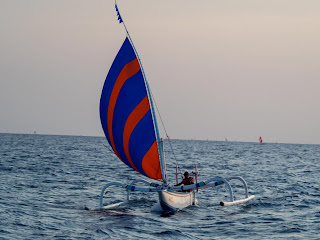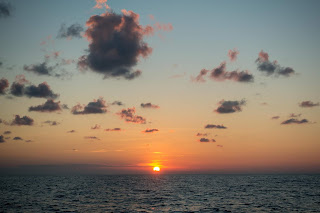Happy Indonesian national day - 17th August. Apparently there's much
celebrating going on, but we are alone in a remote anchorage in Komodo
National Park and will have to celebrate by ourselves, unless some Komodo
 |
| Free-diving fisherman Alor at 10m depth |
dragons and monkeys stage a party on the beach.
There will lots of news to come from Indonesia. We've been here a month now
and are loving it. When the rest of the Oyster World Rally fleet moves on in early September, three boats (ourselves, Lisanne and Miss Tiggy) will be staying on in Indonesia and then making our way north and west to Malaysia,
Singapore, Langkawi,Thailand and possibly Myanmar if we can arrange visas and paperwork, and shipping our boats back to the Mediterranean in April
 |
| Alor reef |
2019. It will be very sad to break away from our family of yachts but we will stay in touch -- and there is lots to look forward to back in England.
Charles has been reading a book called Indonesia - Exploring the Improbable
Nation, by Elizabeth Pisani. It IS an improbable place, with over 17,000
islands and 300 languages. We're assured that Bahasa, the lingua franca, is easy to learn, but we are still frustratingly bad at communicating, mostly relying on smiles and a very limited vocabulary (it does include 'how old are you?' as that's useful when dispensing reading glasses!) The currency, rupiyahs, has way too many zeros. In a largely cash economy, wallets bulge with 100,000 rupiyah notes, worth £5. The smallest note is worth 5 pence! Life is mostly cheap here, so I do have moments of wondering 'is that £1.25 or £12.50?'
The geography of Indonesia (the part we've seen) is stunning. As everyone's been reminded recently, it lies on the ring of fire, and most of the mountains are volcanic cone-shaped. The hills where we are now are arid, baking in the sun, with dramatic rock formations at the shoreline. When we went inland to Kelimutu multi-coloured lakes, though, we drove through
 |
| Alor coral garden |
 |
| Smiling schoolchildren Kalabahi |
 |
| Traditional village Kalabahi |
 |
| FAD |
 |
| Beach BBQ with the Tiggys |
rainforest and mist, and skidded alarmingly on muddy roads when riding pillion on mopeds. There are beautiful beaches, though sadly they are often litter-strewn. Where DO all those flipflops come from?! There's not much
attempt at recycling and towns such as Kupang or Labuan Bajo are very dirty, with gutters heaped with plastic bags and bottles. We did hear of one initiative which uses schoolchildren one afternoon a week to clear beaches,
but it will take more than that to remove the sad tidelines.
Our first encounter with Indonesia was Kupang. Going ashore was a challenge
as there's no dinghy dock, so you were simply dumped on the beach by a wave -- but then a group of locals would rush down to help pull the dinghy up the beach and would look after it all day, moving it when the tide required, for
the equivalent of £2.50. Refuelling was a similar challenge, both here and in Labuan Bajo (a harbour with hundreds of boats) as all diesel had to be transferred to the boat in jerrycans. We transported 600 litres of fuel by
dinghy to our boat and decanted it through a filter. That took an entire afternoon, making me think wistfully of service stations with petrol pumps at home.
Traffic is absolutely crazy here. I don't know what the statistics are, but I imagine road deaths must be very high. Drivers routinely overtake when approaching blind corners and lean on their horns to force the thousands of
mopeds out of their way, occasionally off the tarmac road. Tiny minivans, called bemos, stop wherever they want to let passengers out, even in the middle of intersections. We took a bemo to the traditional fruit and veg
market in Maumere, music blaring as we squeezed our large western bodies onto bench seats designed for smaller people. In remote villages, dogs move frighteningly slowly off the road as you approach and children, seeing white faces through the car windows, burst out laughing. We are the main attraction and people love having their photo taken with us. At a primary school, we were mobbed like celebrities - everybody wanted to shake hands
and introduce themselves.
We've been moving gradually west along the north coast of Flores Island. That's a Portuguese name and that influence lives on in the many Catholic churches here, although the fishing villages on the coast are mainly Muslim
and we are usually awakened by the call to prayer (some much more tuneful than others!) Last Sunday Nicky went to Mass (2 hours, the format completely familiar but entirely in Bahasa - I spent it learning numbers)
and afterwards ran an eye clinic, giving away over 70 pairs of reading
 |
| Eyejuster glasses solve short-sightedness for two sisters |
glasses. As we've moved west, there's been more tourism, though the
facilities for visiting yachts are still non-existent. We've anchored off a
couple of resorts and have been made to feel very welcome by the managers.
At Sea World near Maumere we gave away glasses to staff and at the Puri Sari
Hotel we used their pool and laundry facilities. One enterprising
restaurateur in Labuan Bajo has two farms and supplies such welcome luxuries as salad leaves (21 varieties!), Italian salami and gorgonzola and organic meats. Tiggy got more than she bargained for, though, when she opened the chilled box and found her duck still had its head and feet attached.
 |
| Eventually they will arrive |
But the really amazing and improbable thing about Indonesia is its sea. The diving has been exceptional; Charles said Alor was the best ever -- until he dived the Cauldron near here in Komodo. He and James, Tiggy and Callum did
a two day Advanced Diving course, which means they can dive deeper and in stronger currents. There are lots of strong currents here, which is challenging and exciting even for those on the surface, snorkelling. The
fantastically coloured coral and fish whizz by like a speeded-up film. The soft coral is blown sideways like trees in a gale. At Krokos Reef, where we enjoyed a great beach barbecue with Oyster friends (and some unwelcome sandflies), we drift-snorkelled the pass twice, towing the dinghy behind us. That night, the tide went waaaay out and we had a long walk from the beach to find sufficient depth to launch the dinghies. There was a full moon. Was it that or the distant earthquake in Lombok which caused the tidal anomaly? We have seen so much sealife: giant trevallies, sharks, turtles,
 |
| One of a thousand volcanoes in Indonesia |
rays, lionfish, cuttle fish, a million reef fish. I love the multi-coloured nudibranchs attached to coral: apparently they are snails without shells, which makes them slugs, not usually my favourite creatures, but here they are glorious.
We've had some good sailing but also a fair bit of motoring. The wind can come up or die abruptly and there are very strong currents between islands. Another hazard of Indonesian sailing are FADs or Fish Attracting Devices,
frequently unmarked and unlit. We went into one bay at night with Nicky shining a torch ahead of us and spotting FADs. The following morning, leaving in daylight, we could see many more which we'd been lucky to miss.
There are very few other yachts, but many phinisi or liveaboard dive boats as well as numerous fishing boats, many just canoes with outriggers for added stability. Apparently it brings them good luck if they cut across your bow, which accounts for the sometimes erratic course they take! In some anchorages, boats come to sell or barter - a lobster for a packet of biscuits and a tee shirt? Deal! We've given away dive masks, old halyards,
clothes, saucepans and colouring pencils.
As at home, not everything runs smoothly all the time. I'll let Charles explain about the generator problems we've been having. Or maybe not as your eyes will glaze over about actuators, governors, control panels! Anyway at the moment we can either make water or charge the batteries or run the
washing machine, but not together at the same time! So we can keep going. We hope to be able to fix it in Lombok in early September.
Above all Indonesia is about its very smiley people from small children to adults. Always a wave. Much of the country survives on subsistence farming or fishing; local traditions and families are key. Although we can't understand the language apparently there are hundreds of them, with
different languages from village to village. We have visited genuinely tribal villages in Fotemvasi and the Kingdom of Boti where life hasn't changed for centuries. And yet, mobile phone coverage would have rural UK in rapture and it costs almost nothing. So traditional life and facebook co-exist; almost everyone seems to go to school in different coloured clean uniforms depending on age, but they don't learn much English there and learning by rote seems the norm. We have been to many unspoilt places on our journey and this a different, dirty-in-places kind of unspoilt.








































